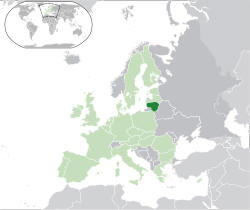|

List of Banks in Lithuania

|
|
Central BankBank of Lithuania
Deposit Money Banks
Currently, 9 commercial
banks holding a license from the Bank of Lithuania are
operating in the country.
AB SEB bankas
AB bankas "Snoras"
AB "Swedbank" (previously AB bankas "Hansabankas")
AB DnB NORD bankas
AB PAREX BANKAS
AB Sampo bankas
AB Šiaulių bankas
AB Ūkio bankas
UAB Medicinos bankas
Foreign Banks Representative OfficesCurrently, 5 foreign
banks representative offices are operating in the country.
Balti Investeeringute Grupi Pank AS Representative Office
Representative office AB RIETUMU BANKA
Representative office AP Anlage & Privatbank AG
Representative office of Balkan Investment Bank AD Banja
Luka
Representative office of Raiffeisen Bank Polska S.A.
Foreign Banks BranchesCurrently, 6 foreign bank branches are
operating in the country.
Allied Irish Banks, p.l.c. branch
AS "UniCredit Bank" Lithuania Branch
Bayerische Hypo - und Vereinsbank AG Vilniaus Branch
Balti Investeeringute Grupi Pank AS branch
MP Investment Bank hf. filialas Baltijos ğalyse
Nordea Bank Finland Plc Lietuvos Branch |
In 2003, before joining
the European Union, Lithuania had the highest economic growth rate
amongst all candidate and member countries, reaching 8.8% in the third
quarter. In 2004 - 7.4%; 2005 - 7.8%; 2006 - 7.8%; 2007 - 8.9%, 2008 Q1
- 7.0% growth in GDP reflects the impressive economic development.
Most of the trade Lithuania conducts is within the European Union.
Vilnius Financial Centre
By UN classification, Lithuania is a country with high average income.
The country boasts a well-developed modern infrastructure of railways,
airports and four-lane highways. As of October 2008, the unemployment
rate is 4.7%. Less than 2% of the population live beneath the poverty
line.[42] According to officially published figures, EU membership
fueled a booming economy, increased outsourcing into the country, and
boosted the tourism sector. The litas, the national currency, has been
pegged to the euro since 2 February 2002 at the rate of EUR 1.00 = LTL
3.4528,[43] and Lithuania is expecting to switch to the euro on 1
January 2014.
Lithuania is part the EU single market.Structurally, there is gradual
but consistent shift towards a knowledge-based economy with special
emphasis on biotechnology (industrial and diagnostic) - major
biotechnology producers in the Baltic countries are concentrated in
Lithuania - as well as laser equipment. Also mechatronics and
information technology (IT) are seen as prospective knowledge-based
economy directions in Lithuania. In 2009 appeared "Barclays" bank IT
centre in Lithuania. In 2010 IBM company with the Lithuanian government
decided to set up a research center in here. Also Lithuanians opened the
first solar cell plant in Lithuania. In 2010 "Western Union" here
decided to establish money transfer centre. Lithuanian government
strategy is as follows: Lithuanian economy is the production of high
added value products and services.
Lithuania has a flat tax rate rather than a progressive scheme.
Lithuanian income levels are lower than in the older EU Member States.
According to Eurostat data, Lithuanian PPS GDP per capita stood at 61
per cent of the EU average in 2008.[44] Lower wages have been a factor
that in 2004 fueled emigration to wealthier EU countries, something that
has been made legally possible as a result of accession to the European
Union. In 2007, personal income tax was reduced to 24% and a reduction
to 21% was made in January 2009.
Corporate tax rate in Lithuania is 15% and 5% for small businesses. The
government offers special incentives for investments into the high-technology
sectors and high value-added products. Lithuania has the highest rating
of Baltic states in the Economist Intelligence Unitâs quality of life
index.
|


